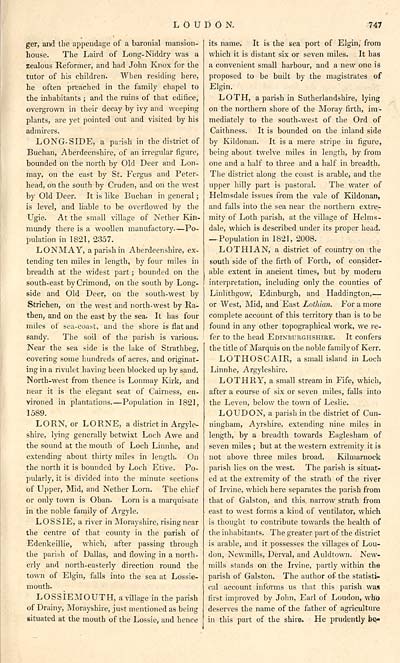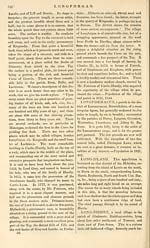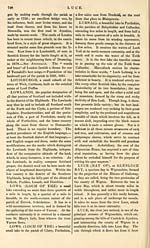Gazetteer of Scotland > Volume 2
(263) Page 747
Download files
Complete book:
Individual page:
Thumbnail gallery: Grid view | List view

LOUDON.
747
ger, and the appendage of a baronial mansion-
house. The Laird of Long-Niddry was a
zealous Reformer, and had John Knox for the
tutor of his children. When residing here,
he often preached in the family chapel to
the inhabitants ; and the ruins of that edifice,
overgrown in their decay by ivy and weeping
plants, are yet pointed out and visited by his
admirers.
LONG-SIDE, a parish in the district of
Buchan, Aberdeenshire, of an irregular figure,
bounded on the north by Old Deer and Lon-
may, on the east by St. Fergus and Peter-
head, on the south by Cruden, and on the west
by Old Deer. It is like Buchan in general ;
is level, and liable to be overflowed by the
Ugie. At the small village of Nether Kin-
mundy there is a woollen manufactory — Po-
pulation in 1821, 2357.
LONMAY, a parish in Aberdeenshire, ex-
tending ten miles in length, by four miles in
breadth at the widest part ; bounded on the
south-east byCrimond, on the south by Long-
side and Old Deer, on the south-west by
Strichen, on the west and north-west by Ra-
then, and on the east by the sea. It has four
miles of sea-coast, and the shore is fiat and
sandy. The soil of the parish is various.
Near the sea side is the lake of Strathbeg,
covering some hundreds of acres, and originat-
ing in a rivulet having been blocked up by sand.
North-west from thence is Lonmay Kirk, and
near it is the elegant seat of Cairness, en-
vironed in plantations. — Population in 1821,
1589.
LORN, or LORNE, a district in Argyle-
shire, lying generally betwixt Loch Awe and
the sound at the mouth of Loch Limine, and
extending about thirty miles in length. On
the north it is bounded by Loch Etive. Po-
pularly, it is divided into the minute sections
of Upper, Mid, and Nether Lorn. The chief
or only town is Oban. Lorn is a marquisate
in the noble family of Argyle.
LOSSIE, a river in Morayshire, rising near
the centre of that county in the parish of
Edenkeillie, which, after passing through
the parish of Dallas, and flowing in a north-
erly and north-easterly direction round the
town of Elgin, falls into the sea at Lossie-
mouth.
LOSSIEMOUTH, a village in the parish
of Drainy, Morayshire, just mentioned as being
situated at the mouth of the Lossie, and hence
its name. It is the sea port of Elgin, from
which it is distant six or seven miles. It has
a convenient small harbour, and a new one is
proposed to be built by the magistrates of
Elgin.
LOTH, a parish in Sutherlandshire, lying
on the northern shore of the Moray firth, im-
mediately to the south-west of the Ord of
Caithness. It is bounded on the inland side
by Kildonan. It is a mere stripe in figure,
being about twelve miles in length, by from
one and a half to three and a half in breadth.
The district along the coast is arable, and the
upper hilly part is pastoral. The water of
Helmsdale issues from the vale of Kildonan,
and falls into the sea near the northern extre-
mity of Loth parish, at the village of Helms-
dale, which is described under its proper head.
—Population in 1821, 2008.
LOTHIAN, a district of country on the
south side of the firth of Forth, of consider-
able extent in ancient times, but by modem
interpretation, including only the counties of
Linlithgow, Edinburgh, and Haddington, —
or West, Mid, and East Lothian. For a more
complete account of this territory than is to be
found in any other topographical work, we re-
fer to the head Edinburghshire. It confers
the title of Marquis on the noble family of Kerr.
LOTHOSCAIR, a small island in Loch
Linnhe, Argyleshire.
LOTHRY, a small stream in Fife, which,
after a course of six or seven miles, falls into
the Leven, below the town of Leslie.
LOUDON, a parish in the district of Cun-
ningham, Ayrshire, extending nine miles in
length, by a breadth towards Eaglesham of
seven miles ; but at the western extremity it is
not above three miles broad. Kilmarnock
parish lies on the west. The parish is situat-
ed at the extremity of the strath of the river
of Irvine, which here separates the parish from
that of Galston, and this, narrow strath from
east to west forms a kind of ventilator, which
is thought to contribute towards the health of
the inhabitants. The greater part of the district
is arable, and it possesses the villages of Lou-
don, Newmills, Derval, and Auldtown. New-
mills stands on the Irvine, partly within the
parish of Galston. The author of the statisti-
cal account informs us that this parish was
first improved by John, Earl of Loudon, who
deserves the name of the father of agriculture
in this part of the shire. He prudently be-
747
ger, and the appendage of a baronial mansion-
house. The Laird of Long-Niddry was a
zealous Reformer, and had John Knox for the
tutor of his children. When residing here,
he often preached in the family chapel to
the inhabitants ; and the ruins of that edifice,
overgrown in their decay by ivy and weeping
plants, are yet pointed out and visited by his
admirers.
LONG-SIDE, a parish in the district of
Buchan, Aberdeenshire, of an irregular figure,
bounded on the north by Old Deer and Lon-
may, on the east by St. Fergus and Peter-
head, on the south by Cruden, and on the west
by Old Deer. It is like Buchan in general ;
is level, and liable to be overflowed by the
Ugie. At the small village of Nether Kin-
mundy there is a woollen manufactory — Po-
pulation in 1821, 2357.
LONMAY, a parish in Aberdeenshire, ex-
tending ten miles in length, by four miles in
breadth at the widest part ; bounded on the
south-east byCrimond, on the south by Long-
side and Old Deer, on the south-west by
Strichen, on the west and north-west by Ra-
then, and on the east by the sea. It has four
miles of sea-coast, and the shore is fiat and
sandy. The soil of the parish is various.
Near the sea side is the lake of Strathbeg,
covering some hundreds of acres, and originat-
ing in a rivulet having been blocked up by sand.
North-west from thence is Lonmay Kirk, and
near it is the elegant seat of Cairness, en-
vironed in plantations. — Population in 1821,
1589.
LORN, or LORNE, a district in Argyle-
shire, lying generally betwixt Loch Awe and
the sound at the mouth of Loch Limine, and
extending about thirty miles in length. On
the north it is bounded by Loch Etive. Po-
pularly, it is divided into the minute sections
of Upper, Mid, and Nether Lorn. The chief
or only town is Oban. Lorn is a marquisate
in the noble family of Argyle.
LOSSIE, a river in Morayshire, rising near
the centre of that county in the parish of
Edenkeillie, which, after passing through
the parish of Dallas, and flowing in a north-
erly and north-easterly direction round the
town of Elgin, falls into the sea at Lossie-
mouth.
LOSSIEMOUTH, a village in the parish
of Drainy, Morayshire, just mentioned as being
situated at the mouth of the Lossie, and hence
its name. It is the sea port of Elgin, from
which it is distant six or seven miles. It has
a convenient small harbour, and a new one is
proposed to be built by the magistrates of
Elgin.
LOTH, a parish in Sutherlandshire, lying
on the northern shore of the Moray firth, im-
mediately to the south-west of the Ord of
Caithness. It is bounded on the inland side
by Kildonan. It is a mere stripe in figure,
being about twelve miles in length, by from
one and a half to three and a half in breadth.
The district along the coast is arable, and the
upper hilly part is pastoral. The water of
Helmsdale issues from the vale of Kildonan,
and falls into the sea near the northern extre-
mity of Loth parish, at the village of Helms-
dale, which is described under its proper head.
—Population in 1821, 2008.
LOTHIAN, a district of country on the
south side of the firth of Forth, of consider-
able extent in ancient times, but by modem
interpretation, including only the counties of
Linlithgow, Edinburgh, and Haddington, —
or West, Mid, and East Lothian. For a more
complete account of this territory than is to be
found in any other topographical work, we re-
fer to the head Edinburghshire. It confers
the title of Marquis on the noble family of Kerr.
LOTHOSCAIR, a small island in Loch
Linnhe, Argyleshire.
LOTHRY, a small stream in Fife, which,
after a course of six or seven miles, falls into
the Leven, below the town of Leslie.
LOUDON, a parish in the district of Cun-
ningham, Ayrshire, extending nine miles in
length, by a breadth towards Eaglesham of
seven miles ; but at the western extremity it is
not above three miles broad. Kilmarnock
parish lies on the west. The parish is situat-
ed at the extremity of the strath of the river
of Irvine, which here separates the parish from
that of Galston, and this, narrow strath from
east to west forms a kind of ventilator, which
is thought to contribute towards the health of
the inhabitants. The greater part of the district
is arable, and it possesses the villages of Lou-
don, Newmills, Derval, and Auldtown. New-
mills stands on the Irvine, partly within the
parish of Galston. The author of the statisti-
cal account informs us that this parish was
first improved by John, Earl of Loudon, who
deserves the name of the father of agriculture
in this part of the shire. He prudently be-
Set display mode to: Large image | Transcription
Images and transcriptions on this page, including medium image downloads, may be used under the Creative Commons Attribution 4.0 International Licence unless otherwise stated. ![]()
| Gazetteers of Scotland, 1803-1901 > Gazetteer of Scotland > Volume 2 > (263) Page 747 |
|---|
| Permanent URL | https://digital.nls.uk/97433978 |
|---|
| Description | Volume II: Glenbanchor to Zetland. |
|---|---|
| Attribution and copyright: |
|
| Description | By Robert Chambers and William Chambers. Glasgow: Blackie & Son, 1838. 2 volumes. |
|---|---|
| Shelfmark | NF.1461.g.7 |
| Additional NLS resources: | |

